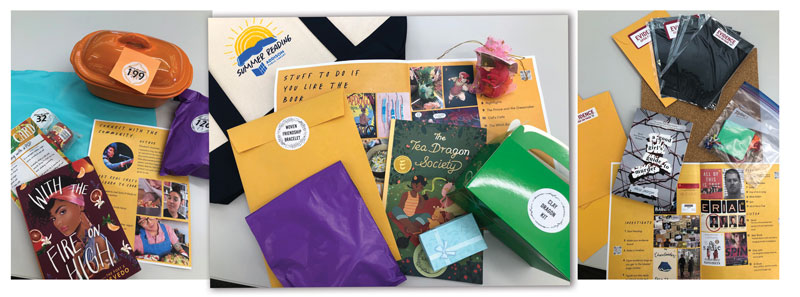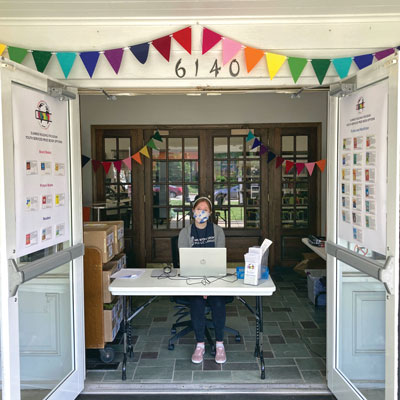Libraries Revamp Summer Reading, Offer Greater Choice in Books and Where to Participate, Including Outdoors
Here’s how six libraries are refreshing their plans for 2022.
 |
The Outdoor Explore program at Allen County Public Library in Indiana |
Such preparation goes into a smooth, exciting summer program—and each year, it’s a new challenge to keep things fresh and manageable for staff. That’s especially true these days. After two years of remote and hybrid programming, with varying levels of success, many schools and libraries have significantly rethought or streamlined their summer reading initiatives, with more reading choice; outdoor, online, or in-person options; and more. Here’s how six libraries are updating and refreshing their plans for 2022.
School summer reading programs are often required assignments to bolster student learning skills during break. Alexandra Patterson’s school recently reevaluated its program to make it more engaging and relevant to students. “We shifted from ‘summer reading’ to ‘community reading’ in an effort to put the power more in our students’ hands” and involve more faculty and staff in book discussions, says Patterson, director of library services at Mercersburg (PA) Academy. The shift to a community focus also indicated “we want more faculty and staff to read the books and participate in the discussions as well.”
Prior to these changes in 2020, an administrator chose one book to read, and students completed an essay about it. Now, a committee of students and faculty works a summer ahead to establish a theme and read books linked to that theme. Students members each pitch a book, and the committee finalizes three contenders. Then, they determine a winner based on its appeal, local and global relevance, and diverse representation. Rather than an essay, students work on a project related to the book, such as a poem or podcast episode, and take part in a student-led discussion on campus. Picks from the last few years included Darius the Great Is Not Okay by Adib Khorram, about an Iranian American teenager’s struggles with identity, and Between the World and Me by Ta-Nehisi Coates, a nonfiction work structured as a letter to the author’s son about being a Black man in America.
Students enjoyed the change, Patterson says. “Long-term, we hope to make it a true ‘community read’ by bringing in the public library, other local schools, and the book club at the local coffee shop.”
Other schools have seen and adapted to the need to be more conscious of the inclusivity of books being assigned for summer reading. For LREI (Little Red School House & Elisabeth Irwin High School) in New York City, the change was not in structure, but in content.
Each year, educators and librarians at the school develop a community reading list. Students read at least two titles on the list over the summer.. When the school year begins, students and educators meet in groups including students from all high school grade levels to discuss.
“Two years ago, we made the choice to do better with the specific books, and all books now feature historically marginalized or underrepresented voices: LGBTQIA+, BIPOC, works in translation, intersectional,” says Karyn Silverman, high school librarian at LREI. “As of this September, 75 percent of our students will have never seen a summer reading list made of predominantly white voices.”
Some titles being considered for 2022 include Firekeeper’s Daughter by Angeline Boulley, Fresh Banana Leaves by Jessica Hernandez, and The Astonishing Color of After by Emily X.R. Pan.
“It was the right change for us, aligned with our mission and our understanding of what it means to educate our students to be active, engaged members of a democracy,” says Silverman.
 |
Book boxes at Addison (IL) Public Library contain activities tied to the books’ themes. |
Public libraries revitalize
Public librarians are bringing successful aspects of online programs, takeaway kits, and streamlined processes into their 2022 plans.
Over the last few years, Chicago-area Addison Public Library (APL) tossed the traditional reading logs, T-shirts, and trinkets in favor of creating an immersive reading experience involving specific books and linked activities.
Staff research suggested that a rewards-based approach wasn’t ideal. Where rewards may help an initially hesitant participant, in the long run, that system hinders intrinsic motivation.
Now, every participant selects a book from a list. Last year there were 12 options for teens and 33 for children of all ages. Participants got to keep the book, along with a tote bag, some goodies, and activities tied to the title.
Inspired by the subscription box model, library and staff created the tote bags to curate crafts, experiments, art, and other activities that emphasized the books’ themes and settings. A Good Girl’s Guide to Murder by Holly Jackson came with a corkboard, pins, and evidence sealed in envelopes to be opened at specific pages. Elizabeth Acevedo’s With the Fire on High, about an aspiring chef, included spices and recipes. Scarves, sensory balls, and crafts gave parents who chose ¡Me gusta cómo soy! / I Like Myself! by Karen Beaumont or Corduroy by Don Freeman everything they needed for at-home story times. And kids who read Peter Brown’s The Wild Robot, a book about survival on a deserted island, were challenged to build a structure for shelter from the sun and test it with UV-sensitive beads, according to Emily Glimco, communications and marketing coordinator. The changes were a hit with 87 percent who participated.
Allen County (IN) Public Library (ACPL) rebranded its whole program. “We love summer reading but wanted to expand our focus to acknowledge that learning and discovery happens in a lot of different ways,” says Marra Honeywell, youth services manager at ACPL.
The Summer Reading Program became “SPARK” (Science, Play, Art, Reading, and Knowledge) to convey that the library is about discovery and exploration, whether at the library itself or through community outreach.
In 2020 and 2021, “We launched to-go kits, virtual programs, and took our programs and story times outside to lawns, parks, and even parking lots,” Honeywell says. The library gave out books for participation, including graphic novels.
The library also reinvented its 20-year-old Team Read program, which employs local teens to help with library outreach. Team Read traditionally sends teenagers to local facilities like parks and community centers to play games, read with children, and serve as mentors. Last summer, the library safely offered Team Read in library branches, too, where teens developed rapport with kids while learning how libraries operate. Honeywell says that the library hired three of the 18 teens after the summer. The 2022 participants can do community outreach work and work at the branches.
 |
The Morton Grove (IL) Public Library moved its sign-up and pickup spot to the front entrance on the first day of the summer reading program. |
Meet people where they are
The summer reading program at Skokie (IL) Public Library (SPL) is a multi-departmental effort. The library hired summer reading assistants to staff desks and help with check-ins. Patrons were required to show up at the library after completing each level of the challenge to earn a badge.
Last year, the library reevaluated the program not only for patrons but for staff, by piloting an online logging option. Turnout for the virtual, self-led program exceeded the library’s expectations: Readers sent the library art, photos, and more to show their enthusiasm.
“People were excited to be doing summer reading with us, even on a smaller scale,” says youth services librarian Caitlin Savage. For efficiency in 2022 as in-person programming picks up, SPL will have a central hub in the building serve as a summer reading one-stop shop where patrons can pick up thematic activities and book recommendations, plus any instructions they may need for activities. They can check in with staff twice during the summer for incentive pickups, as well.
“By eliminating most of the check-ins and simplifying the overall design, we’ve designed a flexible program that will [not] add undue burden to an already taxed staff,” says Becca Boland, SPL supervisor of advisory services. The library will offer both in-person and digital options for summer reading this year with the ability to update if needed, Boland adds.
Meanwhile, the announcement of kids’ reading recommendations at SPL builds excitement. Three committees in the youth services department select books for readers of different ages. The titles are listed on a series of bookmarks. Readers can check off what they’ve read, creating a “sort of mini reading program within a summer reading program,” Savage says. Recently, young readers have been especially eager for graphic novels, while teens have flocked to romance and titles recommended on BookTok.
Learning from what worked–and what didn’t
A pivot to a more robust hybrid summer reading program showed the strengths and weaknesses of such changes at Faulkner County (AR) Library (FCL), which held only in-person programs before. In 2020 and 2021, reading challenges took place on the online platform READSquared, where programs were offered virtually. Patrons could get craft packets at curbside pickup to facilitate engagement at home. The kickoffs and end-of-summer celebrations shifted to a hybrid model.
Not all virtual programs got strong attendance. But rather than scrap everything from two pandemic summers, FCL will use what worked well in 2022.
“We see that the online and the in-person patron communities are different,” says Mary Spears Polk, children’s services librarian. The in-person community is much larger than online, so the library will host summer reading primarily in person. Still, it will keep several changes to serve online and in-person communities.
The library will continue to offer simple take-home craft activities for families. It will also use its online platform to offer a scaled-down weekly program, livestreaming in-library programming where appropriate, and will keep track of the reading challenge with READSquared.. Because of what they’ve learned, FCL will not book events that take place exclusively online. With all these changes, “We have made [summer reading] more accessible,” says Spears Polk.
However libraries reboot their programs, the goal remains the same: get young people excited to read, engage, and talk about what they’re learning between and beyond the covers of a book.
Kelly Jensen is an editor at Book Riot and the editor of three nonfiction YA anthologies.
RELATED
The job outlook in 2030: Librarians will be in demand
The job outlook in 2030: Librarians will be in demand
ALREADY A SUBSCRIBER? LOG IN
We are currently offering this content for free. Sign up now to activate your personal profile, where you can save articles for future viewing






Add Comment :-
Be the first reader to comment.
Comment Policy:
Comment should not be empty !!!